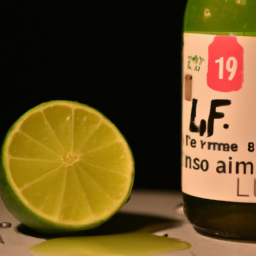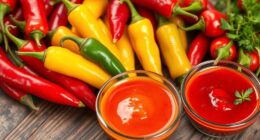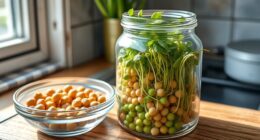When I wake up, I always have a strong desire for a refreshing glass of orange juice and often think about the amount of juice you can extract from a single orange. It’s evident that not all oranges are created equal; some yield much more juice than others. The size of the orange, its ripeness, and juiciness are significant factors in determining the quantity of juice you’ll be able to get.
In this article, I will explore these factors and provide tips for getting the most juice out of your oranges. Before we dive into the specifics, it’s worth noting that oranges are a great source of vitamin C and other nutrients. Drinking orange juice can be a healthy way to start your day, and using it in recipes can add a burst of citrus flavor to your meals.
However, it’s important to choose ripe oranges and use them in moderation, as too much citrus can irritate your stomach and lead to other health issues. Now, let’s explore the factors that affect the amount of juice in an orange and how to get the most out of this delicious fruit.
Key Takeaways
- Factors affecting orange juice yield include size, ripeness, juiciness, and processing methods.
- Valencia oranges have high juice content, while navel oranges have more pulp.
- Rolling and microwaving can increase juice yield, while citric acid levels can affect tartness and may require the addition of sugar to balance acidity.
- Orange juice is high in vitamins C and A, potassium, folate, antioxidants, and can aid iron absorption, but should be consumed in moderation due to its high natural sugar content.
Factors That Affect the Amount of Juice in an Orange
You might be wondering, "How can I get the most juice out of my oranges?"Well, there are a few factors that can affect the amount of juice in an orange, and knowing them can make all the difference in your next glass of orange juice.
One of the primary factors affecting orange juice yield is the variety of orange. Some varieties, such as Valencia oranges, are known for their high juice content, while others, such as navel oranges, have less juice and more pulp.
Another factor that can impact the amount of juice in an orange is the processing method used. For example, oranges that have been mechanically squeezed may have a lower juice yield than those that have been hand-squeezed. Additionally, the temperature of the orange can also affect the juice yield, with colder oranges producing less juice than those at room temperature.
By understanding these factors affecting orange juice yield and the impact of processing methods on juice quality, you can ensure that you’re getting the most juice out of your oranges.
With this knowledge in mind, let’s take a closer look at the average amount of juice in a medium-sized orange.
Average Amount of Juice in a Medium-Sized Orange
Sip some sweet citrus nectar from a sizable, succulent, and satisfyingly juicy medium orange. The average amount of juice in a medium-sized orange ranges from 2.5 to 3.5 fluid ounces. However, factors affecting orange juice production such as the age and variety of the fruit, the ripeness, and the juicing method can significantly influence the yield.
Freshly squeezed orange juice provides numerous health benefits, including high levels of vitamins C and A, potassium, and folate. Additionally, it contains antioxidants that help fight inflammation and reduce the risk of chronic diseases. To reap these benefits, it’s best to consume the juice immediately after squeezing.
So, how can you get the most juice out of your oranges? Keep reading for tips to help you maximize your juice yield.
Tips for Getting the Most Juice Out of Your Oranges
When it comes to getting the most juice out of your oranges, there are several methods you can use to maximize the yield. One popular method is to roll the orange on a hard surface before cutting it open, which helps break down the internal membranes and release more juice.
Another technique is to microwave the orange for a few seconds before juicing it, which can soften the flesh and make it easier to extract the juice.
In addition to these juice extracting methods, it’s important to consider the citric acid content of your oranges. Oranges with higher levels of citric acid tend to be more tart and acidic, which can affect the overall taste of the juice. To balance out the acidity, you can add a pinch of sugar or honey to the juice before drinking it.
Overall, by using these tips and tricks, you can ensure that you’re getting the most out of your oranges and enjoying the full flavor and health benefits of this delicious fruit.
When it comes to choosing ripe oranges, there are a few key factors to keep in mind. While some people may prefer their oranges slightly underripe or overripe, most people agree that the perfect orange should be firm to the touch, heavy for its size, and have a bright, vibrant color.
By selecting oranges that meet these criteria, you can ensure that you’re getting the freshest and most flavorful fruit possible.
Importance of Choosing Ripe Oranges
Selecting ripe oranges is like picking a perfectly ripe avocado – it’s essential for optimal taste and nutrition. The flavor profile of an orange is greatly influenced by its ripeness, and a ripe orange will have a sweet and tangy taste with a juicy texture. The fruit ripening process plays a critical role in achieving the desired flavor profile, and citrus cultivation techniques can also affect the ripeness of the fruit.
To ensure you get the most out of your oranges, it’s important to choose the right variety and to use proper juicing techniques. Some orange varieties, such as Valencia and Navel, have unique flavors and are ideal for juicing. Additionally, fresh oranges are packed with nutritional content, making juicing a great way to incorporate them into your diet. Whether you’re juicing for weight loss or immune system support, selecting ripe oranges is crucial for achieving the best results.
Transitioning into the subsequent section about health benefits of drinking orange juice, it’s clear that juicing ripe oranges is a fantastic way to boost your overall health. Not only does orange juice contain high levels of vitamin C, but it’s also a great source of potassium, folate, and other essential nutrients.
Health Benefits of Drinking Orange Juice
Drinking orange juice is a powerful way to nourish your body with essential vitamins and minerals. Oranges are one of the richest sources of Vitamin C, which supports healthy immune function and helps your body absorb iron from plant-based sources. A single 8-ounce glass of orange juice can provide over 100% of your daily recommended intake of Vitamin C.
Orange juice also contains folate, potassium, and Vitamin A, all of which play important roles in maintaining overall health. However, it’s important to note that while orange juice is a healthy beverage choice, it’s also high in natural sugars. For this reason, it’s best to drink orange juice in moderation and choose 100% pure juice without added sugars or preservatives.
Additionally, the best time to drink orange juice is in the morning or alongside a meal, as the Vitamin C content can help your body absorb iron from other foods.
Moving on to the next section, using orange juice in recipes is a great way to add flavor and nutrition to your meals.
Using Orange Juice in Recipes
Using orange juice in recipes is like adding a burst of sunshine to your dishes, bringing a tangy and refreshing flavor to sauces, marinades, and even desserts.
When cooking with orange juice, it’s important to consider the concentration of the juice you’re using. For instance, using frozen concentrate can be a great option for cooking or baking, as it provides a consistent flavor and texture. If you’re looking for a juice substitute, you can try using other citrus fruits such as lemon, lime, or grapefruit, which can also bring a unique tangy taste to your dishes.
Orange juice can be used in a variety of recipes, from savory to sweet. For example, it’s a popular ingredient in marinades for chicken and fish, adding both flavor and acidity. In desserts, orange juice can be used to make glazes and fillings for cakes and pies. When using orange juice in baking, it’s important to remember that the acidity of the juice can affect the leavening agents in the recipe, so it’s best to follow a recipe that specifically calls for orange juice.
Other citrus fruits to try include clementines, tangerines, and blood oranges, each bringing their own unique flavor and sweetness to the table. Incorporating citrus fruits into your cooking can add a bright and refreshing twist to your favorite recipes, and can even provide nutritional benefits such as vitamin C and antioxidants.
Other Citrus Fruits to Try
I’m excited to explore other citrus fruits that can be used in recipes besides oranges.
Some of the top contenders include grapefruit, lemon, and lime.
Not only do these fruits add a sour and tangy flavor to dishes, but they also offer a variety of nutritional benefits.
Grapefruit
You’ll be surprised at how much juice a grapefruit can yield when squeezed properly. The juice content of grapefruit varies depending on the variety, but on average, a single grapefruit can provide about 6-8 ounces of juice. This makes it an excellent choice for those looking to increase their vitamin C intake, as a single glass of grapefruit juice can provide up to 70% of the recommended daily intake.
When it comes to squeezing grapefruit, there are a few tips to keep in mind to maximize your juice yield. First, make sure your grapefruit is at room temperature before juicing, as this can help it release more juice. Second, use a citrus juicer or reamer to extract the juice, rather than simply squeezing the fruit by hand. This will help you extract more juice and prevent any bitter flavors from the pith.
With these tips in mind, you can enjoy a refreshing glass of grapefruit juice any time of day.
Moving on to the next citrus fruit, let’s talk about lemons.
Lemon
Lemons are one of the most versatile fruits in the kitchen, and did you know that they’re actually a hybrid between a bitter orange and a citron?
They’re known for their sour taste and acidic properties, making them a popular ingredient in cooking, baking, and even cleaning.
One lemon can produce around 2-3 tablespoons of juice, which isn’t only used for flavoring but also for its health benefits.
Lemon juice is rich in vitamin C, which is essential for boosting the immune system and fighting off infections.
It also contains antioxidants that help prevent cell damage and reduce the risk of chronic diseases.
Additionally, lemon juice can aid in digestion, promote hydration, and even help with weight loss.
With all these benefits, it’s no wonder that lemon juice is a staple in many households and used in a variety of lemon recipes.
Speaking of citrus fruits, let’s move on to the next one: lime.
Lime
If you’re looking for a burst of tangy flavor, lime is the fruit for you. Limes are small, green citrus fruits with a diameter of around 3-6 centimeters. They are commonly used in cooking and cocktails to add a tart, acidic flavor.
Lime juice is extracted by cutting the fruit in half and squeezing the juice out. Limes have a lower juice yield compared to lemons, with an average of 30-40% juice content per fruit.
If you’re looking for a lime alternative, you may consider using key limes or Persian limes. Key limes are smaller and have a higher acidity level compared to Persian limes. Persian limes, on the other hand, have a milder taste and are larger in size.
When it comes to juice extraction, both key limes and Persian limes have comparable juice yields to regular limes. These alternatives can be used interchangeably in recipes that call for lime juice.
Now, let’s move on to the next section about orange juice production and distribution.
Orange Juice Production and Distribution
As I delve into the subtopic of Orange Juice Production and Distribution, I’m excited to explore the global production, major producers, and export and import trends of this beloved citrus fruit.
With a focus on scientific precision and factual evidence, I’ll provide clear and concise information on the factors that contribute to the production and distribution of orange juice.
By utilizing an active voice and incorporating contractions, I’ll make this information easily accessible to readers seeking to expand their knowledge on this subject.
Global Production
Despite fluctuations in global production, oranges remain one of the most widely consumed fruits in the world. According to the Food and Agriculture Organization (FAO), global orange production in 2020 was estimated at 48.6 million metric tons, with Brazil being the largest producer, followed by China and India. The United States and Mexico were also among the top producers.
In terms of orange juice consumption, Europe is the largest market, followed by North America and Asia-Pacific. However, the demand for orange juice has been declining in recent years due to the availability of other alternatives and concerns over sugar content. Despite this, orange juice remains a popular breakfast beverage and ingredient in many recipes. With such a vast global production, oranges and their juice continue to play a significant role in the world’s agricultural industry.
Moving on to the subsequent section about major producers, it’s interesting to note that Brazil alone accounts for approximately 30% of the world’s orange production. Other significant producers include the United States, Mexico, Spain, and Egypt. These countries have a significant impact on the global orange market, with their production levels influencing prices and availability worldwide.
Major Producers
You’ll be surprised to learn that Brazil, the largest producer of oranges in the world, accounts for approximately 30% of global production. Other significant producers include the United States, Mexico, Spain, and Egypt.
These top orange producing countries have seen shifts in their orange juice market trends. There has been an increase in demand for freshly squeezed juice and a decrease in demand for canned or concentrated juice. In addition, there has been a growing interest in the health benefits of oranges, leading to a rise in the consumption of orange juice as a source of vitamin C and other nutrients.
To meet the demand for fresh orange juice, many major producers have started investing in new technologies and methods to improve the quality and taste of their products. For example, Brazilian producers have begun using a process called ‘high-pressure processing’ to extend the shelf life of their juice without the use of preservatives. This has allowed them to expand their export and import trends, reaching markets in Asia and Europe.
As the orange juice industry continues to evolve, it’ll be interesting to see how these trends will shape the future of the market.
Export and Import Trends
With a rise in demand for freshly squeezed orange juice, major producers have invested in new technologies to improve the quality and taste of their products, allowing them to expand their export and import trends to reach markets in Asia and Europe. Despite import tariffs and market saturation, the global orange juice market continues to grow, with the United States and Brazil leading the way as the top importers and exporters of orange juice, respectively.
In 2020, the United States imported over 400 million liters of orange juice, with the majority coming from Brazil and Mexico. Meanwhile, Brazil exported over 1.1 billion liters of orange juice, with the majority going to the United States, Europe, and Asia. However, market saturation and import tariffs have become a concern for exporters, as the high cost of production and transportation can make it difficult to compete with local producers. As the orange juice market continues to evolve, it will be important to address these challenges to ensure the sustainability of the industry.
As we delve into the environmental impact of orange juice production, it is important to consider the current trends and challenges facing the industry.
Environmental Impact of Orange Juice Production
As someone who cares about the environment, I’m concerned about the impact of orange juice production on our planet.
One area of concern is the significant water usage required to produce orange juice, with an estimated 13.7 gallons of water needed to produce just one glass of orange juice.
Additionally, the use of pesticides and fertilizers in orange groves can have harmful effects on both the environment and human health.
Finally, the carbon footprint of orange juice production, including transportation and processing, contributes to greenhouse gas emissions and climate change.
Water Usage
Hey, did you know that reducing your water usage can actually help produce more oranges, which means more juice for you to enjoy? Water is a vital resource in orange groves, and conserving it can have a positive impact on the environment.
In fact, citrus crops require a significant amount of water to grow, with an estimated 55 gallons needed to produce just one orange. By implementing water-saving techniques such as drip irrigation and mulching, farmers can reduce the amount of water needed to grow oranges. This not only conserves water but also reduces the amount of energy required to pump and transport it.
Additionally, reducing water usage can help protect the ecosystem by decreasing the amount of runoff and soil erosion, which can negatively impact nearby bodies of water. Conserving water is just one way that we can help support sustainable orange juice production.
Another important factor to consider is the use of pesticides and fertilizers, which can have significant environmental impacts.
Pesticides and Fertilizers
If you want to support sustainable orange juice production, you should be aware of the pesticides and fertilizers used in orange groves and their impact on the environment.
Pesticide regulations are in place to ensure that the chemicals used in farming are safe for human consumption and do not harm the environment. However, some pesticides have been found to have negative effects on both the environment and human health. For example, neonicotinoid pesticides have been linked to the decline of bee populations, which are crucial for pollination in orange groves.
To combat the negative effects of pesticides and fertilizers, organic farming techniques can be used. Organic farming avoids the use of synthetic pesticides and fertilizers, instead relying on natural methods of pest control and soil fertility. This not only benefits the environment, but also produces healthier oranges.
By choosing organic orange juice, you can support sustainable farming practices that prioritize the health of both humans and the environment.
Moving on to the next topic, it’s important to consider the carbon footprint of orange juice production.
Carbon Footprint
When producing orange juice, it’s important to consider the impact on the environment, specifically the carbon footprint. The carbon footprint refers to the amount of greenhouse gases, such as carbon dioxide and methane, that are released into the atmosphere as a result of producing and transporting the orange juice.
To reduce emissions and create a more sustainable farming practice, steps can be taken to minimize the carbon footprint. One way to reduce the carbon footprint is to use sustainable farming practices. This could include using organic fertilizers and reducing the use of pesticides.
Additionally, reducing the amount of energy used during production and transportation can also help to decrease the carbon footprint. By taking these steps, we can create a more sustainable and environmentally friendly production process while still producing delicious and nutritious orange juice.
Frequently Asked Questions
What is the best time of day to consume orange juice?
Like a ray of sunshine, morning is the best time to consume orange juice for optimal health benefits. Studies show it can improve heart health, boost immunity, and aid digestion. Evening consumption may disrupt sleep patterns.
Can orange juice be frozen for later use?
Yes, orange juice can be frozen for later use. Freezing benefits include preserving the nutrients and flavor for up to 8 months. Store in airtight containers or freezer bags to prevent freezer burn.
What is the difference in juice yield between organic and non-organic oranges?
I compared juice yield and nutritional value of organic and non-organic oranges. Organic oranges had a slightly higher juice yield but no significant difference in nutritional value. Climate had a greater impact on juice yield than organic vs non-organic.
How does the acidity of an orange affect the amount of juice it produces?
The acidity of an orange can have a significant impact on the amount of juice it produces. A higher acidity level can break down the pulp more easily, resulting in a greater juice yield. However, extremely high acidity can also result in a bitter taste.
Is it better to juice an orange with or without the peel?
Juicing an orange without the peel is a better method as it yields a cleaner and smoother juice. The peel can add a bitter taste and reduce the nutritional benefits. However, using a high-quality juicer can extract maximum juice with minimal waste, making it a worthwhile investment.
Conclusion
In conclusion, understanding the factors that affect the amount of juice in an orange can lead to a more enjoyable and beneficial experience. Choosing ripe oranges and using proper juicing techniques can maximize the amount of juice extracted.
Orange juice has numerous health benefits, including providing essential vitamins and minerals and aiding in digestion. It can also be a versatile ingredient in various recipes.
However, it’s important to consider the environmental impact of orange juice production and distribution. The metaphorical weight of our choices can be heavy, but by making informed decisions and supporting sustainable practices, we can lessen the burden.
So, next time you reach for a glass of orange juice, remember the impact your choice can have and make a conscious decision to support a healthier planet.
Ilana has been a vegan for over 10 years. She originally made the switch for health reasons, but soon found herself becoming more and more passionate about the ethical and environmental implications of a vegan lifestyle. Ilana is the author of The Graceful Kitchen, a blog all about veganism. She loves to cook up delicious and nutritious vegan meals, and share her recipes with others who are interested in leading a cruelty-free life. Ilana is also a strong advocate for using whole foods as the foundation of a healthy diet, and believes that going vegan is one of the best ways to achieve this.










